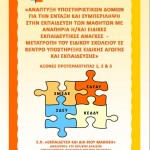Παρουσίαση ΚΕΔΔΥ Χανίων
KE.D.D.Y.
HANIA – CRETE – GREECE
ΑΓΑΠΗ ΟΡΦΑΝΑΚΗ
Δασκάλα Ειδικής Αγωγής
AGAPI ORFANAKI
PRIMARY SCHOOL TEACHER OF SPECIAL EDUCATION
BRISTOL, U.K.
The Centre of Evaluating Differences, the Differential Diagnosis and Support Service as known as (KE.D.D.Y.) in Chania, is a decentralized Public Service of the Ministry of Religion, Culture and Education. It is part of the Primary Education as well as the Secondary Education.
( it is a Law for Special Needs and Education 3699/2008, ACT 199/t.a. / 02-10-2008 )
PURPOSE:
School and social integration of children with disabilities and special educational needs.
Offer assessment services, diagnosis and support these students
Information and awareness of teachers, parents and society
In (KE.D.D.Y.) Chania, students of pre-school and schoolchildren aged from 4 to 18, are evaluated and with the support of a multidisciplinary team aiming :
a) The diagnosis in differentiation 1, the diagnosis of these students, in order to make recommendation for enrollment and attendance in the appropriate school or other educational module framework or program Special Needs and Education as well as monitoring and evaluation of their educational path.
b) Support these students in order to promote physically, mentally, emotionally, socially, morally as far as the possibilities allow and to join in the school and social environment, in an atmosphere of fairness, freedom, security and compliance of their personality. In this context, the student, the teacher and parents supported by the interdisciplinary team of ( KE.D.D.Y.).
1The differential diagnosis is the process through which exclude diseases with similar symptoms to end up to the prevailing diagnosis.
Which students belong to the category of people with disabilities and special educational needs:
All those students who for all or a certain period of their school life show significant learning difficulties which according to the multidisciplinary evaluation affect the process of learning and school adaptation due to:
Intellectual disability
Sensory impaired vision ( blind, partially sighted and low vision)
Sensory disability hearing ( deaf, hard of hearing)
Physical disabilities
Chronic incurable diseases
Speech disorders
Specific learning difficulties ( dyslexia, dysgrafia, dyscalculia, reading inability and spelling problems)
syndrome attention deficit with or without hyperactivity
pervasive development disorders ( autism spectrum)
emotional disorders
multiple disabilities
ALSO:
Students with complex cognitive, emotional and social difficulties, delinquent behavior due to abuse, parental neglect and abandonment or because of domestic violence, belong to people with special educational needs.
Pupils with special educational needs are the students who have one or more mental skills and talents developed to an extent that far exceeds the expected for their age group.
Do not fall within the Special Education and Training:
Students who have poor school performance linked causally to external factors such as language or cultural differences.
Responsibilities of KE.D.D.Y.
Recommendation for customized training in collaboration with classroom teachers and special education staff
Proposing the parallel support, where a written opinion established the hours of parallel support according to each case
Provide continuous counseling and information to the teaching staff and to those involved in educational procedure and training
Determining the type of training aids and technical instruments that facilitate access to the site and learning process needs child in school or at home
Recommend the replacement of written tests for students with disabilities and special educational needs in oral or other form of testing (multiple – choice questions etc.)
PRINCIPLES of Special Education
Reports – Proposals for any building or logistical interventions be made to Special Education and General Education Schools the responsibility of KEDDY.
• Education is compulsory for all students with disabilities and special educational needs.
• Successful integration of students with disabilities and special educational needs presupposes accessible educational environment.
• Full accessibility for students with disabilities and special educational needs in all School Units of the area requires building, logistical assistance. Applying the principles of “Design for All” to ensure accessibility for people with disabilities is compulsory and in the design of training programs and educational materials, including electronic.
How can Integration be successful?
The collaborates of KEDDY:
Principals of Primary and Secondary Education
School counselors of Special and General Education
Principals and teachers of School Units of General and Special Education
Parents of pupils
With public bodies of the Ministry of Health and Social Solidarity
IN ORDER
to ensure effective support for learning design and implement personalized or group educational programs.
The individualized education program includes all of the goals and learning objectives (short term, long term), and those involved in the education of that student, to collaborate and improve learning conditions and achieve better results in terms of learning and social skills.
Conditions effective support for teaching, the design
and implementation of individualized education program:
encourage interactive learning
encourage active student involvement in teaching affairs
focus more on what the student can make
positive educational environment
expectation of the teacher
KE.D.D.Y. STAFF
Principal
Head Secretary
Education staff
(Special Education Teachers of Primary and Secondary Education)
Special Education Staff
(Social Workers, Psychologists, speech-therapists, teachers of physical education, child-psychiatrists, ergo -therapists, etc ).
THANK YOU
FOR YOUR ATTENTION !!!
28/5/2013

